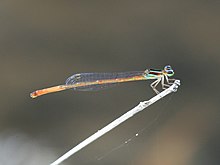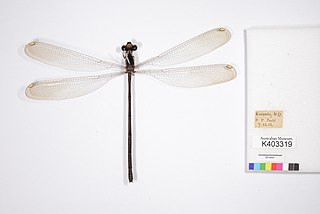
Podopteryx is a damselfly genus. It belongs in the subfamily Argiolestinae of the flatwing damselfly family Megapodagrionidae. They are very large damselflies found in Indonesia, New Guinea and Australia.

Agriocnemis is a genus of damselfly in the family Coenagrionidae. Agriocnemis is distributed widely across Africa, South-east Asia, Indonesia, Australia and islands in the Pacific. They are small insects, commonly known as wisps.

Anaciaeschna is a genus of dragonflies in the family Aeshnidae. Species of Anaciaeschna are found in Africa, Asia and Australia.
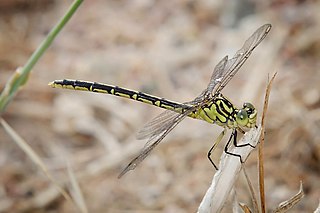
Austrogomphus is a genus of dragonflies in the family Gomphidae, endemic to Australia. Species of Austrogomphus are tiny to medium-sized dragonflies, black in colour with yellowish markings. They are commonly known as hunters.

Ictinogomphus is a genus of dragonflies in either the family Gomphidae or Lindeniidae. They are medium to large, yellow and black with clear wings. Species occur in Africa, Asia and Australia.
Teinobasis is a genus of damselflies in the family Coenagrionidae. Species occur in south-eastern Asia, Indonesia, Solomon Islands and Micronesia; one species, Teinobasis rufithorax, is found in Australia.

Tetrathemis is a genus of dragonflies in the family Libellulidae. Species of Tetrathemis are found in Africa, Madagascar, Asia, New Guinea and Australia.
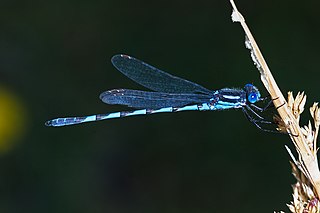
Austrolestes is a genus of medium to large-sized damselflies in the family Lestidae. Austrolestes dragonflies sit with their wings folded completely back. Males are usually bright blue and black, the females duller. Members of this genus are found in Australia, New Zealand and South Pacific islands.

Diphlebia is a genus of damselflies in the family Lestoideidae. They are commonly known as rockmasters. These damselflies are very large and thick. The species in this genus are found in Eastern Australia, except for one species that can be found in New Guinea. The males are vividly patterned. They are blue or bluish green and black in colour. Their blue colour also gives them the name azure damselflies. They rest with their wings spread out. Their wings are usually blackish brown or have white markings. These damselflies have several present antenodal crossveins. The two basal crossveins extend across costal and subcostal spaces. The larvae are wide and flat. They have long saccoid gills enabling them to breathe underwater. The inner tooth of their labial palps is elongated. The specific characters of the larva are mid-ventral, distal width, basal width, and length of median lobe.

Austroargiolestes is a genus of damselflies in the subfamily Argiolestinae of the family Megapodagrionidae. They are commonly known as Flatwings; unlike many other damselflies, at rest their wings are spread out flat.
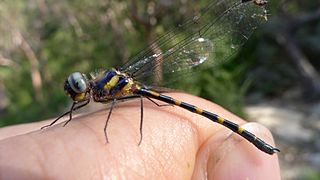
Cordulephya is a genus of dragonflies in the family Cordulephyidae, endemic to eastern Australia. The species are small to tiny in size, coloured black, or purplish-black, with yellowish markings. Unusually for Anisoptera, these dragonflies rest with their wings folded above their body in a similar manner to many species of damselfly. They are commonly known as shutwings.
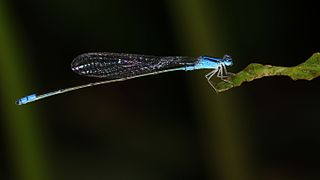
Archibasis is a genus of damselflies belonging to the family Coenagrionidae. These damselflies are generally medium-sized with bright colouring. Archibasis occurs in southern Asia, Indonesia, New Guinea and Australia.

Austroagrion is a genus of damselflies belonging to the family Coenagrionidae. Species of Austroagrion are small dragonflies; males are black with blue or green markings while females are paler. Austroagrion occurs in Papua New Guinea, New Caledonia and Australia.

Austrocnemis is a genus of damselflies belonging to the family Coenagrionidae. Species of Austrocnemis are tiny, bronze-black damselflies with long legs. They occur in New Guinea and Australia.

Synlestes is a genus of damselflies in the family Synlestidae. Species of Synlestes are very large damselflies, metallic green to dark bronze or black in colour with white, yellow or orange markings. Unlike many other damselflies, they spread their wings when resting. They are endemic to eastern Australia where they inhabit streams.

Teinobasis rufithorax is a species of damselfly in the family Coenagrionidae, commonly known as a red-breasted longtail. It is found on Cape York Peninsula, in Queensland, Australia, and on Torres Strait islands, Maluku Island, Aru Islands, New Guinea, Bismarck Archipelago and the Solomon Islands. It inhabits shaded, deep waters.
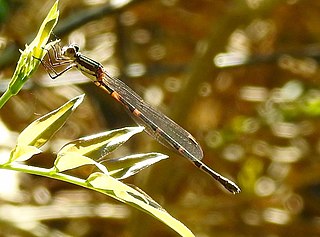
Austrolestes leda is an Australian species of damselfly in the family Lestidae, commonly known as a wandering ringtail. It is found across eastern Australia where it inhabits slow and still water.

Diphlebia lestoides is a species of Australian damselfly in the family Lestoideidae, commonly known as a whitewater rockmaster. It is endemic to south-eastern Australia, where it inhabits streams and rivers.

Synlestes weyersii is a species of Australian damselfly in the family Synlestidae, commonly known as a bronze needle. It is endemic to south-eastern Australia, where it inhabits streams and rivers.
